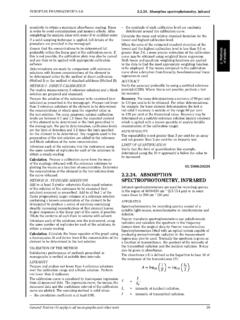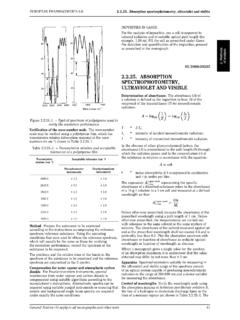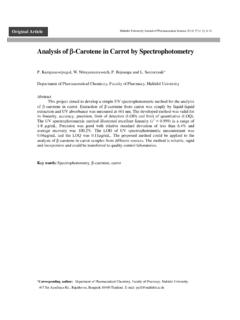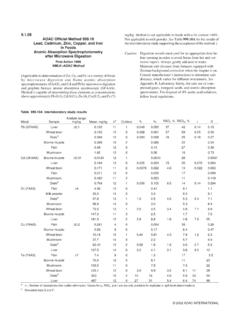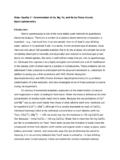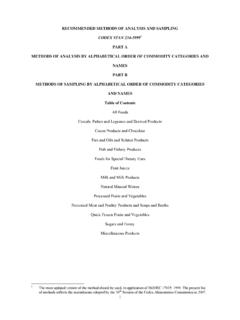Transcription of Determination of sun protection factor (SPF) of sunscreens ...
1 Revista Brasileira de Ci ncias Farmac uticasBrazilian Journal of Pharmaceutical Sciencesvol. 40, n. 3, , 2004 Determination of sun protection factor (SPF) of sunscreens by ultravioletspectrophotometryEliz ngela Abreu Dutra, Daniella Alman a Gon alves da Costa e Oliveira, Erika Rosa Maria Kedor-Hackmann*, Maria In s Rocha Miritello SantoroDepartamento de Farm cia, Faculdade de Ci ncias Farmac uticas, Universidade de S o PauloThe aim of this research was to determine the sun protection factor (SPF) of sunscreens emulsions containing chemical and physicalsunscreens by ultraviolet spectrophotometry. Ten differentcommercially available samples of sunscreen emulsions of variousmanufactures were evaluated.
2 The SPF labeled values were in therange of 8 to 30. The SPF values of the 30% of the analyzedsamples are in close agreement with the labeled SPF, 30% presentedSPF values above the labeled amount and 40% presented SPFvalues under the labeled amount. The proposed spectrophotometricmethod is simple and rapid for the in vitro Determination of SPFvalues of sunscreens emulsions.*Correspondence:E. R. M. Kedor-HackmannDepartamento de Farm ciaFaculdade de Ci ncias Farmac uticas UPSAv. Prof. Lineu Prestes, 580 Bloco 13 Cidade Universit ria05508-900 - S o Paulo SP BrazilE-mail: sunscreens Cosmetic products Sun protection factor UV spectrophotometryINTRODUCTIONThe rapid growth of commercially available productscontaining sunscreens indicates that even though a suntanis still desired, people are conscious of the possible dangersof photoaging and skin cancer, occurring as a result of year, about one million people are diagnosedwith skin cancer and about die from malignantmelanoma.
3 Most skin cancer occurs on the areas of thebody that are most frequently exposed to the sun, such asthe face, neck, head and back of the hands (SAX, 2000).The harmful effects of solar radiation are causedpredominantly by the ultraviolet (UV) region of theelectromagnetic spectrum, which can be divided into threeregions: UVA, from 320 to 400 nm; UVB, from 290 to 320nm and UVC, from 200 to 290 nm. UVC radiation isfiltered by the atmosphere before reaching earth. UVBradiation is not completely filtered out by the ozone layerand is responsible for the damage due to sunburn. UVAradiation reaches the deeper layers of the epidermis anddermis and provokes the premature aging of the radiations have been implicated as a causativefactor of skin to these facts, sunscreens substances are nowincorporated into everyday products such as moisturizers,creams, lotions, shampoos, mousses, and other hair andskin regular use of these products may help to reducethe chance of the harmful effects of ultraviolet , it is necessary that a very efficient sunscreensubstance is used in the cosmetic efficacy of a sunscreen is usually expressed bythe sun protection factor (SPF)
4 , which is defined as the UVenergy required to produce a minimal erythema dose(MED) on protected skin, divided by the UV energyrequired to produce a MED on unprotected skin(Equation 1):E. A. Dutra, D. A. G. C. Oliveira, E. R. M. Kedor-Hackmann, M. I. R. M. Santoro382 The minimal erythemal dose (MED) is defined as thelowest time interval or dosage of UV light irradiationsufficient to produce a minimal, perceptible erythema onunprotected skin (Wood et al., 2000; Wolf et al., 2001).The higher the SPF, the more effective is the productin preventing sunburn. Nevertheless, it is necessary tostandardize methods to determine the SPF of these photoprotection afforded by topical sunscreensagainst solar ultraviolet radiation exposure can bedetermined in vivo or in vitro, and it is ideally determinedby phototesting in human volunteers.
5 This type ofdetermination has been used for many years and althoughuseful and precise, is a time consuming process, complexand expensive, particularly when information concerningto the protection against long wavelength (UVA) isrequired (Azevedo et al., 1999; Gasparro et al., 1998). Asa consequence, much effort has been devoted to thedevelopment of in vitro techniques for assessing thephotoprotection of sunscreen methods in vitro are in general of two which involve the measurement of absorption orthe transmission of UV radiation through sunscreenproduct films in quartz plates or biomembranes, andmethods in which the absorption characteristics of thesunscreens agents are determined based on spectro-photometric analysis of dilute solutions (Fourneron et al.)
6 ,1999; Gordon, 1993; Mansur et al., 1986; Pissavini, M. etal., 2003; Walters et al., 1997).Mansur et al. (1986), developed a very simplemathematical equation which substitutes the in vitromethod proposed by Sayre et al., (1979), utilizing UVspectrophotometry and the following equation:Where: EE (l) erythemal effect spectrum; I (l) solar intensity spectrum; Abs (l)- absorbance of sunscreenproduct ; CF correction factor (= 10). It was determinedso that a standard sunscreen formulation containg 8%homosalate presented a SPF value of 4, determined by UVspectrophotometry (Mansur et al., 1986).The values of EE x I are constants. They weredetermined by Sayre et al. (1979), and are showed inTable aim of this research was to determine the SPFvalues of sunscreens emulsions containing chemical andphysical sunscreens by UV spectrophotometry applyingMansur mathematical equation (Equation 2).
7 MATERIALS AND METHODSR eagents and samplesEthanol (Merck ) analytical available sunscreen emulsions ofvarious manufactures were purchased from localpharmacies. The samples are showed in Table DU-70 UV/Visible spectrophotometer,equipped with 1 cm quartz cell, computer and printer g of all samples was weighed, transferred to a100 mL volumetric flask, diluted to volume with ethanol,followed by ultrasonication for 5 min and then filteredthrough cotton, rejecting the ten first mL. A mL aliquotwas transferred to 50 mL volumetric flask and diluted tovolume with ethanol. Then a mL aliquot wastransferred to a 25 mL volumetric flask and the volumecompleted with absorption spectra of samples in solution wereobtained in the range of 290 to 450 nm using 1 cm quartzcell, and ethanol as a blank.
8 The absorption data wereobtained in the range of 290 to 320, every 5 nm, and 3determinations were made at each point, followed by theapplication of Mansur I - Normalized product function used in thecalculation of SPF (Sayre et al., 1979)Wavelength ( nm)EE x I (normalized) erythemal effect spectrum; I solar intensityspectrumDetermination of sun protection factor (SPF)383 RESULTS AND DISCUSSIONThe SPF is a quantitative measurement of theeffectiveness of a sunscreen formulation. To be effectivein preventing sunburn and other skin damage, a sunscreenproduct should have a wide range of absorbance between290 and 400 nm. Evaluation of the efficiency of asunscreen formulation has for a long time been assessedthrough in vivo test, which is performed with humanvolunteers.
9 In vivo test is time- consuming, is normallyTABLE II - SPF labeled and found in the commercially available samplesCommercial sampleActive IngredientAmountLabeled SPF Found SPF*(function)(%) (Emulsion for body)octyl (Emulsion for body)octyl (Emulsion for body)octyl dioxide and (Emulsion for body)octyl (Sunblock lotion)octyl dioxide and (Emulsion for body)octyl (Emulsion for body)octyl (Emulsion for body)octyl (Emulsion for body)octyl methoxycinnamate;titanium dioxide and zinc oxideJbenzophenone-3 Not (Emulsion for face)octyl methoxycinnamateoctyl salycilate* Experimental data obtained in this research.
10 M = 6E. A. Dutra, D. A. G. C. Oliveira, E. R. M. Kedor-Hackmann, M. I. R. M. Santoro384subject to certain degree of variability, not mention theethical problems of testing with human. The in vitro SPFis useful for screening test during product development, asa supplement of the in vivo SPS this research ten different commercially availablesunscreen products were evaluated by UV spectro-photometry applying Mansur mathematical equation(Mansur et al., 1986). The SPF labeled values were in therange of 8 to 30. These products and SPF values ofsamples obtained using the UV spectrophotometricmethod were shown in Table II. It can be observed that theSPF values found for samples B, C and D are in closeagreement with the labeled SPF.










